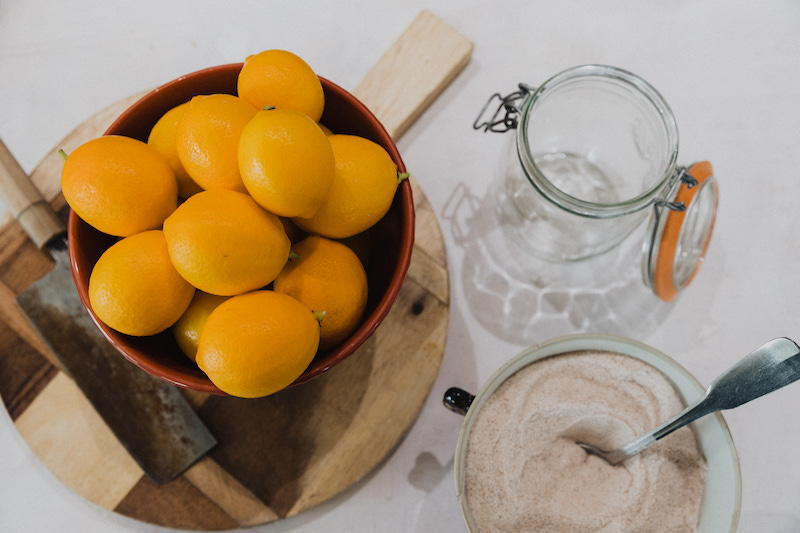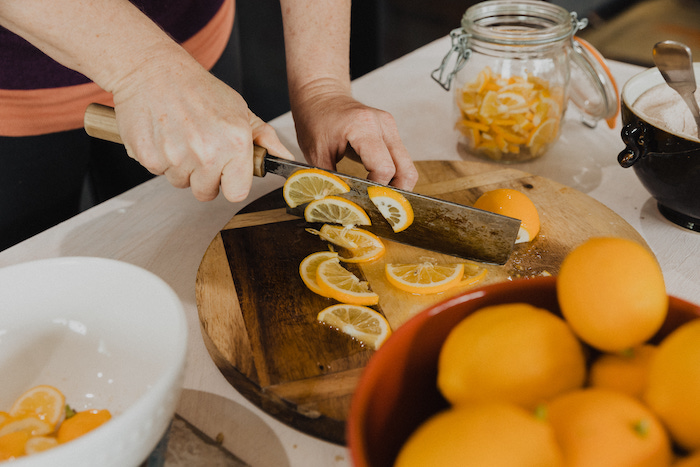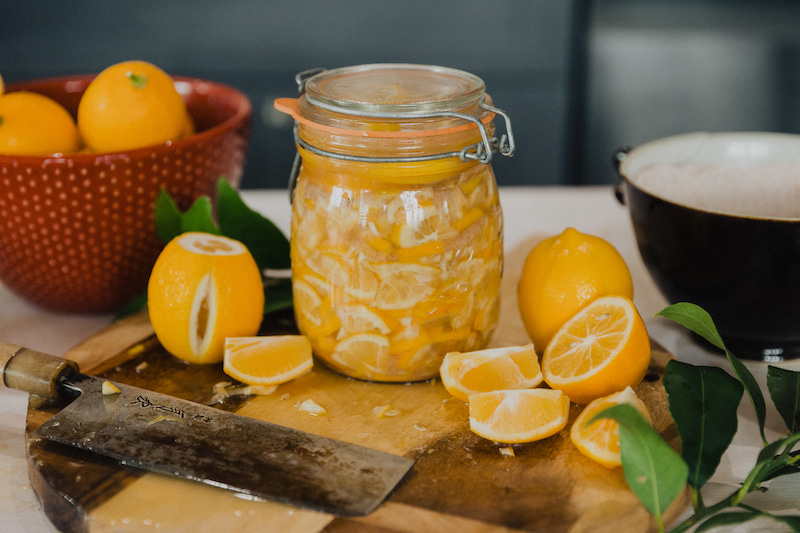Confessions of a Germophile: Sheila Shupe Makes Preserved Lemons
Photos by Tammy Horton
Lemon trees are the zucchini plant of fruit trees. You get so many lemons you have to freeze juice by the gallon, turn them to marmalade, give them to every member of your family (even the ones you don’t like), and you STILL have more on the tree. Clearly this is why the pickled lemon was born. And why, according to my sources, in Casablanca you will see them on your eggs in the morning, in your roasted carrot salad at lunch, and in your tagine at dinner.
I admit, dear reader, I have not been to Morocco yet, and I met my first preserved lemon just last summer. My friend Jenny from New Orleans brought a jar of unimpressive soggy yellow puree to a party and I politely turned away. But after a long conversation about our mutual love of germs and a quick taste, I was hooked. I secreted the jar away during the chaos of clean-up and enjoyed it myself for the next few months.
Just like sauerkraut or my jalapeños escabeche, preserved lemons are a kind of lacto-fermented pickle: using the ancient technique of salting a fruit or vegetable to kill the bad bacteria and culture the good.
You can add them to your next Mezze platter or pop them in a sandwich, but I think their best use is as a flavor enhancer. I added Jenny’s pulp to soups, beans and marinades, and my favorite tradition became a spoonful in my tea with honey each morning. It makes the perfect probiotic, vitamin-enhanced electrolyte booster for any tea or water. In Ayurvedic medicine, preserved lemons are a cure for stomach ails, and I also found out that the pectin in the white inner rind is high in soluble fiber, aka prebiotics. This is the fuel for your good gut bacteria and a much-missing element in our modern diet.
 From Fez to Cambodia, India to EastAfrica, cooks have been pickling their lemons for ages with spices vary from region to region: bay leaves, peppercorns, cinnamon or cardamom. I even saw one recipe that added sugar to help temper the tartness and the salt. You can cut your lemons and spice them the way you like to make your own magic. Some recipes will also use fresh lemon juice, but over video chat with a Moroccan mom the other day I was told specifically to add “Nothing. Nothing but salt. Nothing.”
From Fez to Cambodia, India to EastAfrica, cooks have been pickling their lemons for ages with spices vary from region to region: bay leaves, peppercorns, cinnamon or cardamom. I even saw one recipe that added sugar to help temper the tartness and the salt. You can cut your lemons and spice them the way you like to make your own magic. Some recipes will also use fresh lemon juice, but over video chat with a Moroccan mom the other day I was told specifically to add “Nothing. Nothing but salt. Nothing.”
Personally, I listen to Moroccan moms, so I’m keeping mine simple. A friend from Forestville dropped a box of home-grown Meyer lemons on my porch the other day so I want to let the fruit do the talking. In North Africa they mostly keep them whole, cutting deep slits to allow the salt to penetrate the inner fruit, but these take one month to a year to culture. I’m going with thin slices, which will start to mellow in about two weeks. The rind is the most prized for its aroma and delicate lemon flavor. But when preserved, all parts of the lemon are edible, so no matter how you cut them, they will steal the show.
 My girl from N’awlins blended hers after they fermented, which makes a convenient paste to season soups and stews. Anyone who cooks a lot knows that when seasoning a savory dish there is this magical point between the acid and the salt where you can’t taste the tart or the salty anymore, you can only taste the yum. This is exactly what preserved lemons will do for you. It’s umami in a jar. So, lovelies, when life gives you lemons, pickle those puppies and get ready to fall in love with your new secret weapon in the flavor department.
My girl from N’awlins blended hers after they fermented, which makes a convenient paste to season soups and stews. Anyone who cooks a lot knows that when seasoning a savory dish there is this magical point between the acid and the salt where you can’t taste the tart or the salty anymore, you can only taste the yum. This is exactly what preserved lemons will do for you. It’s umami in a jar. So, lovelies, when life gives you lemons, pickle those puppies and get ready to fall in love with your new secret weapon in the flavor department.
Preserved Lemons Ingredients
6-8 lemons, depending on size (use Meyer or Eureka lemons for their thinner rinds)
Approximately 1-2 teaspoons of salt for each large lemon
Optional: whole spices of choice like bay leaves, peppercorns, basil, garlic cloves or a cinnamon stick
Instructions
- Slice lemons in half, then in thin slices— between an eighth to a quarter of an inch.

- Salt the bottom of the jar with a half a teaspoon of salt.
- Pack the slices from a whole lemon into the jar.
- Spoon a heaping teaspoonful of salt over the lemons.
- Repeat layers until the jar is full.
- If using spices, layer them between lemon layers.
- The salt will draw out the juice, so at about three quarters of the way up, press down and the lemons will be covered with their own juices. You can also add fresh lemon juice if needed to keep lemons covered.
- Be sure all lemons are covered with brine.
- Seal the jar with a lid and leave out on the counter for two weeks, or until the rind is translucent.
- Transfer to the fridge when lemons are at their desired softness.
- Chop or blend lemons and add to dressings, marinades, soups and stews.
Note: These are very salty. Go easy if it’s your first time using them in recipes. Start with a little and go from there. Some people even rinse the lemons to get rid of some of the salt.
